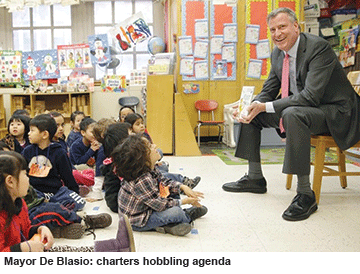 OF THE 658 schools in Chicago, only 126 are charter schools — publicly funded but independently run and largely free of union rules. Fifteen more are due to open this year. More notable, though, is that four of the most recently approved charters are in areas where the city recently decided to close 49 public schools — the largest round of such closures in America’s history.
OF THE 658 schools in Chicago, only 126 are charter schools — publicly funded but independently run and largely free of union rules. Fifteen more are due to open this year. More notable, though, is that four of the most recently approved charters are in areas where the city recently decided to close 49 public schools — the largest round of such closures in America’s history.
Most of the closed schools served poor black children, and were in parts of the city with a shrinking population. The city government argued that these schools were under-used, and that closing them would save $233 million (Rs.1,422 crore) that could be reinvested. So it has been: in new science labs, computers, wireless, libraries, art rooms and air conditioning in the charters that admitted children from the closed schools.
Charters have worked well in Chicago. Most parents like them, and Mayor Rahm Emanuel and the Board of Education are behind them. A 2013 study by Stanford University found that the typical Illinois charter pupil (most of them in Chicago) gained two weeks of additional learning in reading, and a month in maths, over their counterparts in traditional public schools. One city network of charters, Youth Connection, is credited with reducing Chicago’s dropout rate by 7 percent in a decade.
Some argue that charters cream off the brighter children and leave sink schools, deprived of resources, behind. The teachers’ unions hate charter schools because they are non-unionised. So they remain a rarity nationwide, with only 5 percent of children enrolled in them. But a PDK/Gallup poll last year found that 70 percent of Americans support them. Small wonder, a study of charter high schools in Florida found that they boosted pupils’ earning power in later life by more than 10 percent.
But New York’s new mayor, Bill de Blasio, a teachers union-backed Democrat, wants to hobble charters. First, he intends to curb their growth. On January 31 Carmen Fariña, his schools chancellor, announced a plan to divert $210 million earmarked for charter schools to help pay for pre-kindergarten teaching. She also announced that in future, every expansion plan will be reviewed — even those that are long settled, such as the plan of Success Academies, which has the largest charters network in the city, to open ten more public schools in August.
De Blasio wants to charge charters rent if they are sharing space with the 1.1 million pupils in district schools. Because charters receive no state funding for facility costs, and rents in the Big Apple are so high, Michael Bloomberg, de Blasio’s predecessor, allowed them free use of under-utilised space in traditional public schools. Of the 183 charters in New York City, 115 are “co-located”, sharing canteens, libraries and gyms. If they were suddenly charged rent, many would struggle.
These new policies are likely to be unpopular. New York City’s charter schools generally outperform neighbouring district schools. In some cases, charters have not merely closed the racial achievement gap, but actually reversed it. Most New Yorkers want more of them.
Parents, particularly those in high-risk areas, want choice. Demand for charter-school places outstrips available slots; entry is by lottery, and some 50,000 children are on waiting lists. Recently, 20,000 parents, children and teachers marched across the Brooklyn Bridge to City Hall in support of charter schools. Many in the charter world hope de Blasio will back down, though the rhetoric from City Hall is not encouraging.
(Excerpted and adapted from The Economist)